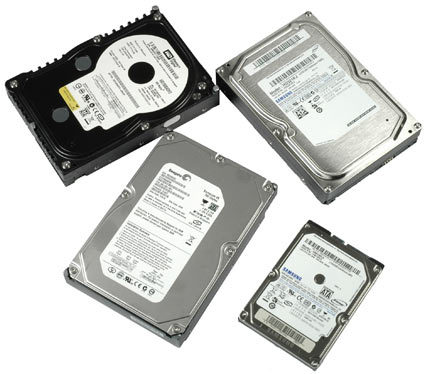The Power Saving Guide, Part 2
Hard Drive
There are three factors that influence the performance and energy requirements of hard drives: the form factor (3.5" vs. 2.5"), the rotation speed (10,000, 7,200 or 5,400 RPM) and the number of platters (one to five). The interface and the performance mode (minimum access time mode vs. quiet mode) have an impact as well, but for desktop PCs these differences are negligible.
We found that three questions are of interest:
- Does it make a difference whether you use a WD Raptor 10,000 RPM drive or a 7,200 RPM drive?
- Does the platter count make a significant difference at 7,200 RPM?
- Does it make sense to use a 2.5" drive for desktop PCs to reduce the energy requirements?
We used a Western Digital WD1500 Raptor at 10,000 RPM and 150 GB, a Seagate Barracuda 7200.10 at 7,200 RPM and 750 GB (four platters), a Samsung SpinPoint T166 HD321KJ at 7,200 RPM and 320 GB (two platters), and a Samsung HM160JI 2.5" drive at 5,400 RPM and 160 GB to get answers.
7,200 RPM: Single Or Multiple Platters
The comparison between a four-platter and a two-platter hard drive results in a measurable but not really important difference: you can save approximately 2 W by using a hard drive with fewer platters. The energy difference increases to 3-4 W if you compare single-platter drives with five-platter monsters. Although this shouldn't really influence the basic buying decision, it still makes sense to purchase hard drives with the highest storage density per platter, because you typically receive the best performance while also requiring the least power. A good example is the Samsung SpinPoint T166, which runs two platters at 166 GB capacity each. You could also purchase an older SpinPoint T133 at the same capacity of 320 GB, but the T133 is based on three platters, which consumes slightly more energy, and the T133 is slightly slower as well.
10,000 RPM Vs. 7,200 RPM
The 10,000 RPM WD Raptor clearly requires more power, but the difference we measured in idle is only about 4 W when compared to the two-platter Samsung HD321KJ, or 2 W in comparison to the four-platter Seagate 7200.10. Power users shouldn't hesitate to get the Raptor, although single-platter 7,200 RPM hard drives at 160 GB are much more efficient and still reasonably fast. If you're interested in a performance comparison between the Raptor and many other hard drives please check out our Interactive HDD Charts.
3.5" Vs. 2.5" Drives
Finally, there is the shootout between the 3.5" hard drives and a 5,400 RPM 2.5" notebook hard drive. As expected, the energy requirements of the 2.5" drive are considerably smaller: on average, you will save up to 10 W in idle.
Get Tom's Hardware's best news and in-depth reviews, straight to your inbox.
Current page: Hard Drive
Prev Page Graphics: GeForce 6, 7, 8 Compared Next Page Power Requirements Of Add-On Cards
Patrick Schmid was the editor-in-chief for Tom's Hardware from 2005 to 2006. He wrote numerous articles on a wide range of hardware topics, including storage, CPUs, and system builds.
